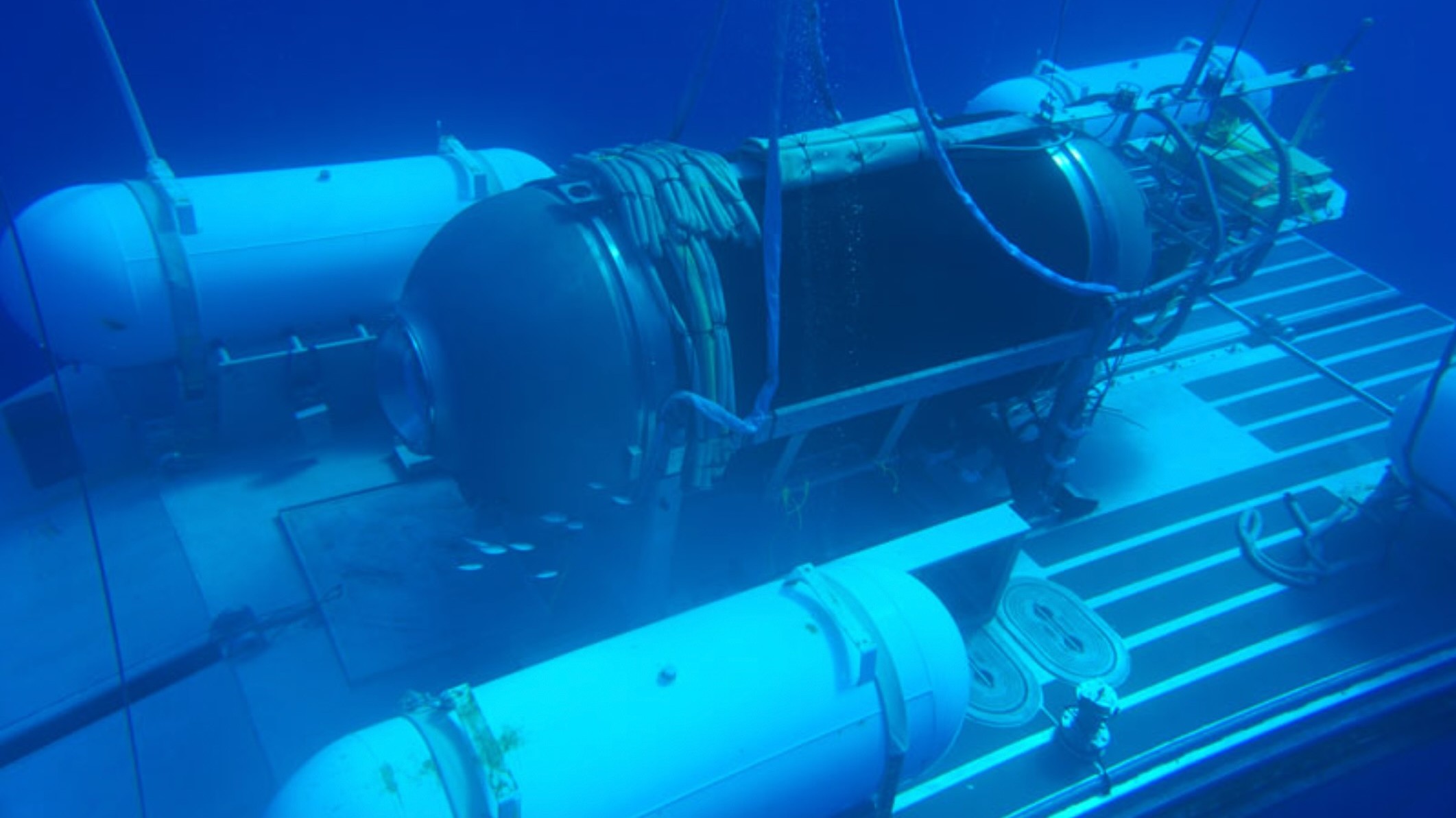
The submersible that went missing with five people on board during a dive to the wreck of the Titanic on Sunday (June 18) was built with NASA's help.
Washington-based company OceanGate consulted engineers at NASA's Marshall Space Flight Center in Alabama during the development of the deep-sea submersible, which is called Titan.
The collaboration came via a Space Act agreement with the agency, according to OceanGate.
"NASA's expertise in the design and automated fiber placement lay up of composite hulls was extremely valuable on this project," OceanGate founder and CEO Stockton Rush said in a March 2022 statement.
"The ability to construct Titan's pressure hull with aerospace-grade carbon fiber and manufacturing protocols results in a submersible which weighs a fraction of what other deep-diving crewed submersibles weigh," he added. "This weight reduction allows us to carry a significantly greater payload which we use to carry five crewmembers: a pilot, researchers and mission specialists."
Related: 10 extraordinary ocean worlds in our solar system (photos)
The NASA assistance isn't the missing submersible's only space connection. One of the people on board, for example, is businessman and explorer Hamish Harding, who flew to suborbital space with Jeff Bezos' rocket company Blue Origin in 2022.
Get the Space.com Newsletter
Breaking space news, the latest updates on rocket launches, skywatching events and more!
Another crewmate on board the troubled Titan is Shahzada Dawood, vice chairman of the Pakistan-based conglomerate Dawood Hercules Corporation. Dawood is a trustee of the SETI (Search for Extraterrestrial Intelligence) Institute in Mountain View, California.
The other three crewmembers are Rush, Dawood's 19-year-old son Suleman and explorer and former French Navy diver Paul-Henry Nargeolet, according to the BBC.
Titan (which shares its name with Saturn's largest moon) has made a number of successful dives to and from the wreck of the Titanic, which famously went down in the North Atlantic during its debut voyage in 1912.
Planetary scientist Alan Stern, who leads NASA's New Horizons mission to Pluto and the outer solar system, went on one of those dives. Former NASA astronaut Scott Parazynski has made the Titanic-wreck trip as well, and he joined OceanGate's board of directors last year.
In addition, OceanGate said last week that SpaceX's Starlink megaconstellation would be providing internet service for this most recent Titanic dive.
The Titanic struck an iceberg and went down about 400 miles (640 kilometers) off the coast of Newfoundland, killing about 1,500 of the roughly 2,200 people on board. The wreck sits 2.4 miles (3.8 km) beneath the North Atlantic waves, making it difficult to get to. Indeed, the ship's final resting place wasn't even discovered until 1985.
Contact with the Titan submersible was lost Sunday about an hour and 45 minutes after it departed from its mother ship to descend into the depths, according to the BBC. (Submersibles such as Titan must be hauled to and from their drop zones, whereas submarines can make such trips on their own).
It's thought that the submersible had enough oxygen to sustain its crewmates for about 96 hours when it went missing. It's unclear what went wrong or where Titan is now, though an intense search is underway.
Join our Space Forums to keep talking space on the latest missions, night sky and more! And if you have a news tip, correction or comment, let us know at: community@space.com.

Michael Wall is a Senior Space Writer with Space.com and joined the team in 2010. He primarily covers exoplanets, spaceflight and military space, but has been known to dabble in the space art beat. His book about the search for alien life, "Out There," was published on Nov. 13, 2018. Before becoming a science writer, Michael worked as a herpetologist and wildlife biologist. He has a Ph.D. in evolutionary biology from the University of Sydney, Australia, a bachelor's degree from the University of Arizona, and a graduate certificate in science writing from the University of California, Santa Cruz. To find out what his latest project is, you can follow Michael on Twitter.
-
Kehk in a MiG It’s not so much a "rescue" as a recovery operation. Unless the sub is still cruising around, it very likely sank below crush depth and imploded. They did not feel any pain though; the collapse happens in milliseconds, to fast for nerve signals to reach the brain.Reply -
ndave61 ummmmmmmm it's there to view the titanic which sits on the sea bottom so it can handle the max depth it has go............ if it keeps its integrity sounds like the integrity was compromised on the way downReply -
Unclear Engineer I hope that surface support ship is listening to the sounds under the surface as well as whatever communication channels they are using. If so, then a "crush" accident should have been detectable on the sonar listening system.Reply
We really aren't being told much about what is known and what is not known, or even what equipment is being used to find and maybe retrieve the submersible. Maybe that is because some of it is military hardware with classified capabilities. At least I hope it is that, instead of not having anything that is really useful available. -
Unclear Engineer This morning, there are reports of tapping sounds at 30 minute intervals, with ~40 hours of oxygen left. So, it seems like rescue is still possible, but first they need to accurately locate the source of the tapping sound.Reply
I am wondering how well the submersible is insulated. It seems like the problem is an electric power failure of some sort, since no communication and no propulsion. It is awfully cold down there - I hope body heat is sufficient for survival as long as the oxygen lasts.









